ISSN ONLINE(2278-8875) PRINT (2320-3765)
ISSN ONLINE(2278-8875) PRINT (2320-3765)
K Srinivasan1, P Jeevapriyadharshini2, A Karpagam3, S Pavithra4
|
| Related article at Pubmed, Scholar Google |
Visit for more related articles at International Journal of Advanced Research in Electrical, Electronics and Instrumentation Engineering
Spinning is the process of conversion of fibre into yarn. The spinning process includes various operations such as cotton mixing, carding, combing, drawing, winding. Winding is the final process in spinning mill where the yarn of small quantity is wound into a big package known as cones. The important aspect in winding is removal of defects or faults in yarn produced. In manual winding when there is discontinuity of thread, during removal of faults, the knot is made by a human. This reduces the quality of yarn. To overcome this disadvantage, autoconer is used. Autoconer is an advanced machine used in winding process to get a high quality yarn with low man power. Here, threads are spliced automatically. Splicing means the process of opening of broken ends and retwisting the ends after the removal of faults. Here the joined yarn looks like parent yarn. Thus, the quality of yarn is enhanced. The drawback of autoconer is, waste collected by suction motor gets deposited on the suction panel and it should be disposed manually for a periodic time interval. If the waste is not removed it reduces the operating efficiency of the suction motor. This leads to reduction in quality of yarn. The aim of the proposed work is to design an automatic waste removal system using PLC (Programmable Logic Controller) which helps us to further increase the efficiency of the suction motor and thus the quality of yarn.
Keywords |
| Winding, Autoconer, Suction motor, Quality control |
INTRODUCTION |
| Spinning is the part of the textile manufacturing process. It is the process of twisting together of drawn out strands of fibres to form yarn, though it is colloquially used to describe the process of drawing out, inserting the twist, and winding onto bobbins. Quality is an important factor to be considered in all industries. Quality of textile is based on type of yarn used. So that, all manufactures of yarn concentrate more in quality so that they can withstand in the market. To be able to make agreements, accurate values which characterize quality are required. Quality of the products are provided by the testing instruments for example, for assessing the quality of fibres, slivers, rovings and yarns .Without the availability of such reliable values, it would be extremely difficult or even impossible to form the basis for a dialogue with the modern textile world. Therefore, great importance is attached to the accuracy and reproducibility of the quality determining values. Table 1 shows the results of inter-laboratory tests for analysing the quality of yarn. |
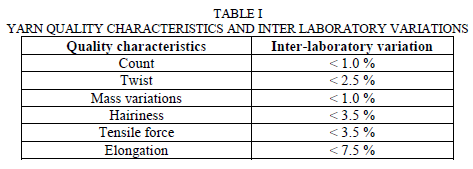 |
| Though quality is an important factor at the same time productivity is also plays a key role. So that manufactures consider productivity with quality. Therefore, any method which is used to improve the quality should not affect the productivity. In this paper, it reports on the development of an automatic waste removal system to enhance the quality of yarn by considering the yarn properties and also to maintain its productivity. Though the process stops for few minutes to remove the accumulated waste, it maintains its productivity and high quality yarn is obtained. |
PROCESS IN SPINNING |
| Spinning is the process of conversion of fibre into yarn. There are various operations takes place in spinning such as cotton mixing, combing, carding, drawing, winding. Fig.1 shows the flow diagram of spinning process. |
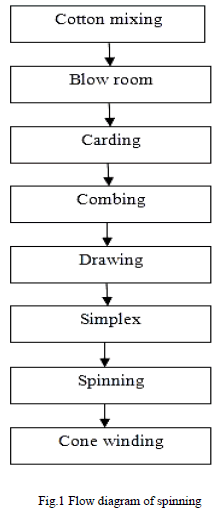 |
| A. Cotton mixing |
| Cotton is the natural fibre and procured from different stations. The properties of cotton such as strength, length, color gets vary. So that in cotton mixing process 4 to 5 lots are mixed to get specified quality yarn. |
| B. Blow room |
| Blow room includes opening, cleaning, mixing or blending, micro dust removal, uniform feed to the carding machine and recycling of the usable waste. |
| C. Carding |
| Carding is defined as the reduction of an entangled mass of fibres to a filmy web by working between two closely spaced, relatively moving surfaces clothed with sharp wire points. Carding process includes opening to individual fibres, elimination of impurities and dust, removing of neps, elimination of short fibres, fibre blending, fibre orientation, and sliver formation. |
| D. Combing |
| Combing process includes elimination of precisely pre-determined quantity of short fibers, elimination of the remaining impurities and elimination of a large proportion (not all) of the neps in the fiber material, formation of a sliver having maximum possible evenness, producing of more straight and parallel fibers. |
| E. Drawing |
| Drawing is a process of quality improvement in spinning mill. Drawing part of the fibres is affected by fibres being carried along with the roller surfaces. For this to occur, the fibres must move with the peripheral speed of the rollers. The output will be paralled strand of fibres which is known as sliver. |
| F. Simplex |
| Simplex is an intermediate process in which the draw frame sliver is drafted, twisted and wound into a package known as bobbin which is used to feed spinning machines. |
| G. Spinning |
| Spinning is the process where the yarn is produced. The simplex bobbin are fed to this machines where they are drafted, twisted and wound in small packages known as ring cops, weighing 50gms each. |
| H. Winding |
| Winding is the process of making yarn into a suitable package ready for sales. Apart from the above, another primary aim is to eliminate the faults in yarn. Neps, thick places, thin places, count variations are some of the notable defects in the spinning yarn which has to be removed, while winding into suitable package known as cone. |
| 1) Manual winding |
| In manual winding, the faults are removed using either mechanical slub catcher or electronic yarn cleaner. This processes is more labor intensive and the faults can be cleared only to a limited extend, say 8 breaks per lakh metre. The speed of winding will be 450 metre per minute. Every worker is allotted for 40 winding heads .So the production will be limited .Here when any faults is noted by EYC (Electronic Yarn Cleaner), the yarn is cut down then the worker , using knoter joins the yarn by a knot. |
| 2) Autoconer |
| The main drawbacks of manual winding are labor intensive, less productive and less effective. In order to overcome the limitations , the autoconer winding machine has been introduced four decades ago , now the fifth generation machine is also been launched .The improvements in autoconer machine has been a continues process . In autoconer machine, the speed is 1300 metre per minute. The EYC used, will clear the faults to the maximum possible extend. Usually 50 to 60 breaks per lakh metre faults are cleared .The joining of the ends is made by a unique process known as splicing ,were the ends are opened, mingled and retwisted by which the appearance will be uniform and knot is eliminated here. The labor requirement is very much reduced and the splicing is carried out by the machine itself. The autoconer machines are now been widely used to overcome the labor shortage, improve machine productivity and the quality of yarn dispatched for sales.Fig.2 gives the block diagram of autoconer. |
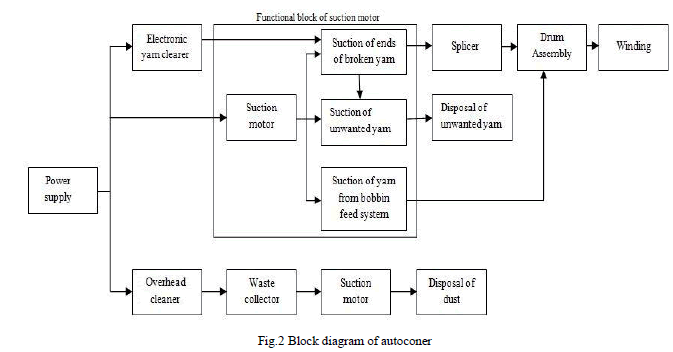 |
| When power supply is given, suction motor starts working. Suction motor performs mainly three operations. First, when there is any discontinuity in thread, the two ends of the thread are sucked and spliced automatically. Sensor is used to sense the continuity of the thread. Second, when thread from the present bobbin gets over, thread from next bobbin is sucked and winding process continues. Third, unwanted yarn which is known as hard waste is collected with the help of suction motor. Accumulated waste are then disposed manually.Fig.3 explains clearly about the step by step process of autoconer. |
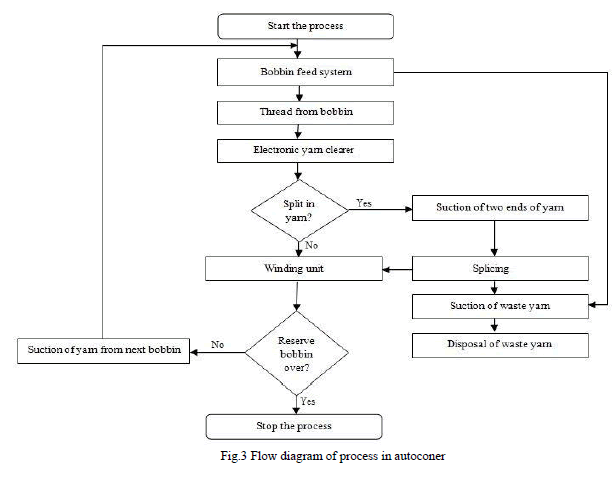 |
| Fig.4 shows the layout diagram of autoconer. With the help of layout diagram we can identify the design of autoconer. |
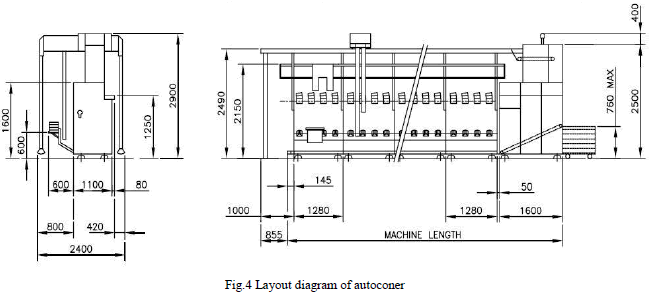 |
PROPOSED METHOD |
| As quality is an important factor, we focussed on the quality as well as productivity of yarn. In autoconer the hard waste which gets accumulated on the panel should be removed periodically. The hard waste accumulated here are not recyclable. In present autoconer, this waste should be removed manually. If these waste are not removed, this reduce the working efficiency of the suction motor. So this may lead to the decline in the quality of yarn. In our proposed method we used PLC (Programmable Logic Controller) to design an automatic waste removal system in autoconer for improvement in the quality of yarn. Fig.5 shows the block diagram of the proposed work. This helps to retain the quality and productivity of the yarn. |
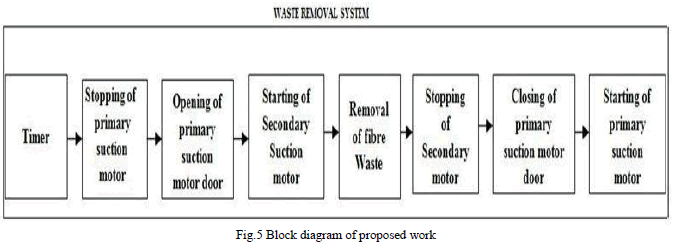 |
| The steps involved in this process are given below: |
| Step 1: When timer reaches the specified time, stop the primary suction motor |
| Step 2: Open the door of primary suction motor automatically |
| Step 3: Start the secondary suction motor |
| Step 4: Remove the accumulated waste |
| Step 5: Stop the secondary suction motor |
| Step 6: Close the door of primary suction motor |
| Step 7: Start the primary suction motor |
EXPERIMENTAL RESULTS |
| In autoconer, the pressure of suction motor should be maintained at 60 mbar. When the hard waste is accumulated more there is a drop in the pressure and so suction power is also decreased. This reduces the efficiency.Fig.6 shows the variation in efficiency between different spindles.Fig.7 shows the variations in the cycle/knot between different spindles. These variations are due to improper suction. |
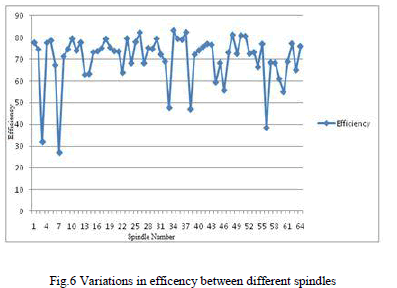 |
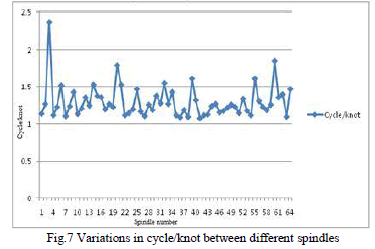 |
| Fig.8 shows the overall efficiency of suction motor and quality of yarn after implementing the proposed idea. |
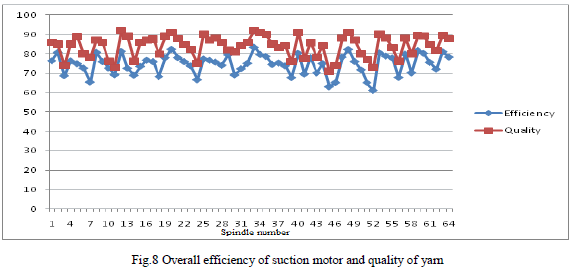 |
CONCLUSION |
| This paper has reported on the development of an automatic waste removal system in autoconer for quality improvement of yarn. As yarn is a base material for textile manufacturing we concentrated on improving the quality of yarn. By removing the accumulated waste automatically for a periodic interval of time, working efficiency of suction motor is improved; this in turn improves the operation of autoconer and thus the quality of yarn. Though the winding process stops for few minutes it does not affect the productivity. |
ACKNOWLEDGMENT |
| We are very glad to thank Sri Ramakrishna Engineering College, Coimbatore and Department of Electronics and Instrumentation Engineering for providing the laboratory set up to conduct the experiments of our proposed work. We also express our deep thanks to Mr. B. Sridhar for helping us technically to study about the operation of autoconer. |
References |
|